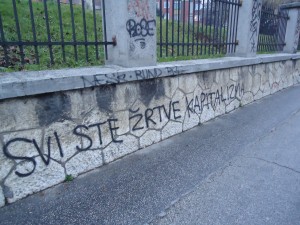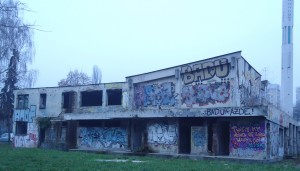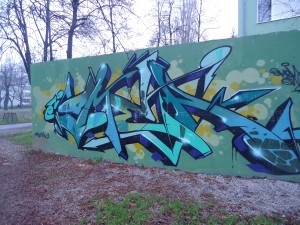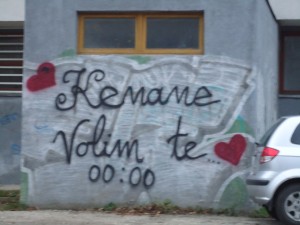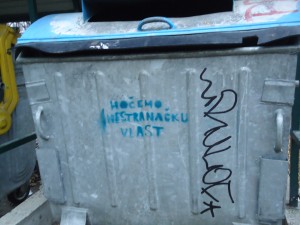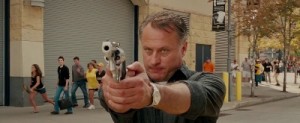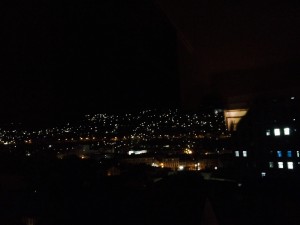I’m completely out of my element–and it shows. I’m scouring the streets looking for signs of vandalism, stopping to scrutinize scribbles–most of which mean nothing–with the hope that I will find a political message or something relevant to some academic theory.

An apartment building that was hit by mortar rounds during the war. Someone came along and added the sarcastic (and misspelled) statement, “beautiful facade!”
Other foreigners I pass on the street are on their way to go site-seeing or clubbing. I’m crouching behind dumpsters and stairwells taking pictures of crude drawings and catch phrases.
Most of my colleagues are requesting interviews with professors, scholars, politicians, and activists. I’m texting figures who call themselves things like Sicko, TruStyle, or Plimp.
My roommates are carefully crafting emails with formal greetings, introductions, and explanations about the program’s privacy policy to assure their interview participants that their identities will be protected and their perspectives properly quoted. I’m sending Facebook messages and getting responses like: “is there any money in that,” and “what u need and want.” (Yep, not even a question mark at the end).
I did get in contact with a somewhat prominent conceptual artist in Sarajevo, who completely blew me off by saying the war has been over for 20 years. He sent me a second email later with a link to a YouTube video of the song “Happy Xmas (War is Over).”
But I’m doing well. “Well”=2 weeks into a 4 week project I realize I need to reconfigure a few things. Like my thesis. And the material I read. And how I choose to organize my paper. And what kind of graffiti I’m looking for now.
I met a local graffiti artist who opened my mind to thinking about graffiti in a new way–a way that happened to redefine my project. He doesn’t write political graffiti, but he is well-versed in graffiti’s history and understands its political implications. He told me that first, graffiti is vandalism (which isn’t an insult to his work, he said, because “vandalism” is a challenge to the system– something he takes pride in). Second, graffiti is freedom. It is a way to take ownership of public space and to show the government that people have personal sovereignty. In the U.S., we see graffiti and think “this is a bad area;” but this artist said that he sees graffiti and thinks “this city is alive.”
If graffiti indicates life, then yes, Sarajevo is very much alive. This is especially powerful to realize at the end of a semester dedicated to studying the war here 20 years ago. There is something painfully, beautifully ironic about seeing signs of life scrawled between bullet holes and shell-pocked spaces. It shows that people here survived and that they kept their city alive by leaving traces of their existence on its walls.
Let’s not romanticize graffiti too much–I’m not talking about awe-inspiring murals that will spark world peace or win a prize of some sort. My project is about basic writing, whether with spray-paint, stencils, markers, or a sharp object used to scratch a surface. Writing which says provocative political statements, random names, jokes, memories of the war or just advertisements and notices like “don’t put trash here.” But still, I’m learning that graffiti says much more than just the words.
